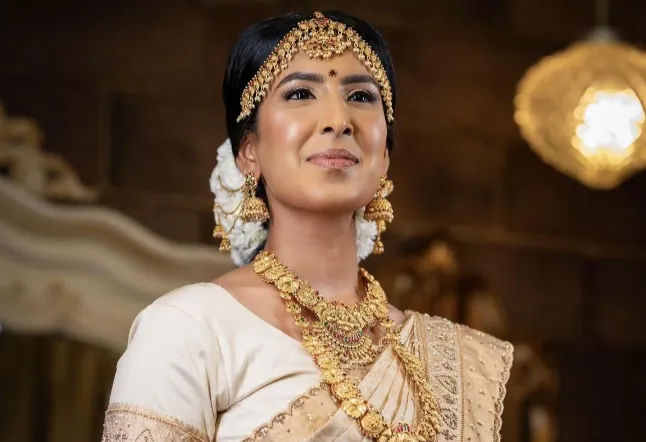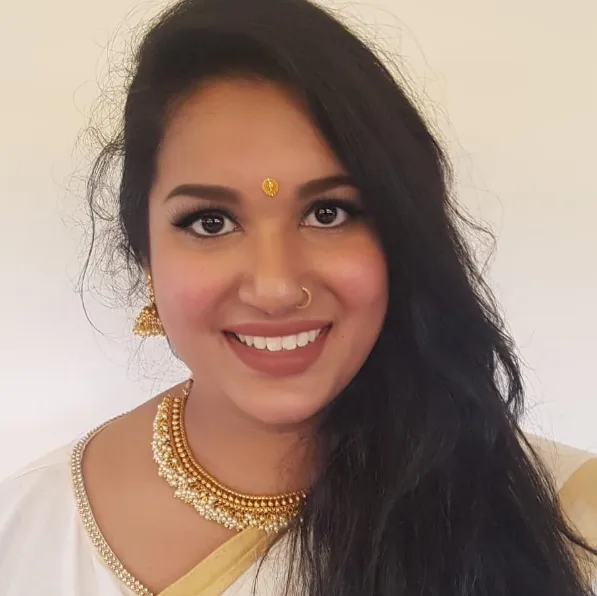Timeless kanjivaram saris making a comeback
Owning a Kanjivaram is undoubtedly a form of investment, much like Rolex or Patek Philippe wristwatches, says Saranya Devan.

Bride, Rivania Pillay in a Kanjivaram sari
Image: NVV weddings.
The recent welcome break allowed me to spend more time on social media platforms such as Facebook, Instagram and TikTok, and I came across posts on many Indian weddings. What took me by surprise was the resurgence of South Indian silk saris, especially Kanjivaram saris, making a larger presence at South African weddings.
I recall that about a decade ago, Kanjivaram saris faded from the wedding scene as Swarovski stone-studded saris began trending. Some cheaper versions were so rich with dazzling sequins and mirrors that to really appreciate the design, you had to reach for the sunglasses.
Now before I get bashed for being a hater, I must submit that I am a “pukka” South Indian “ponnu” who, thanks to my parents’ great taste and initial investment in my South Indian wardrobe, saw me turning into a full-on connoisseur of silk saris.
Owning a Kanjivaram is undoubtedly a form of investment, much like Rolex or Patek Philippe wristwatches. These saris are known for their durability and longevity, and many families pass down their well-maintained Kanjivaram saris as heirlooms from one generation to the next. I am fortunate to have my own collection, which I have grown during my frequent visits to Chennai. I am also blessed that I also have a few of my paternal grandmother’s Kanjivaram saris, which are more than 60 years old. These are safely kept away.
Kanjivarams originate from Kanchipuram in Tamil Nadu, a city revered for its temples and classical architecture. These saris are reputed for their intricate designs, rich textures, intricate zari or golden thread work and vibrant colours, and are considered one of the finest and most luxurious forms of silk saris in India.
The Kanjivaram, deemed the queen of saris, is a strong symbol of Tamil identity and pride, much like spicy rasam or tamarind-infused fish curry. The legendary Carnatic vocalist, MS Subbulakshmi, loved Kanjivaram saris, especially in a serene and tasteful shade of blue. The MS blue sari became a symbol of understated elegance after she wore it during her iconic performances.
Beyond their aesthetic appeal, Kanjivaram saris hold cultural and religious significance. Motifs like peacocks, mango leaves, elephants, and traditional geometric patterns are commonly featured, each carrying deep symbolic meanings. A classic Kanjivaram temple border sari is a sure head-turner and a must have in any woman’s wardrobe. The handwoven craftsmanship of these saris adds to their uniqueness and value.
In the book The Sari that I recently came across thanks to dear family friend and fellow sari fanatic, Dr Nirmala Moodley, author Linda Lynton, a respected scholar in Indian textiles and ethnic art, meticulously examines the sari's design evolution, regional variations, and symbolic meanings. This book, which presents over 200 colour photographs, tells us so much about the details, effort and thought that goes into each sari.
I am always impressed by how South Asians in Canada are doing so much to sustain culture. The growing interest in Kanjivaram saris among young women in Canada reflects a broader trend of cultural appreciation and fashion innovation. By blending traditional elements with modern styling, they are ensuring that this timeless garment continues to thrive in contemporary fashion.
Tia Bhuva, a Canadian fashion brand, founded by Tia Thambinayagam in 2017, is aiming to modernise the sari-wearing experience by combining traditional elegance with contemporary comfort.
While traditional Kanjivaram saris have long been favoured by older generations as you will see at any Bharatanatyam or Carnatic music performance at the Music Academy in Mylapore, I am thrilled that younger South Africans are increasingly incorporating them into their wardrobes. Damn isn’t this so exciting.

Saranya Devan
Image: Supplied
Saranya Devan is a theatre-maker, dance performer, academic and proud Tamilian. She holds an MA in dance from UCT, and a MA in Bharatha Natyam from the University of Madras.
Related Topics: